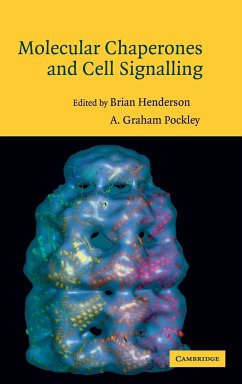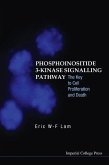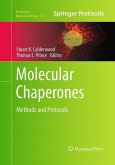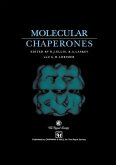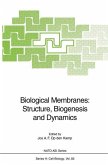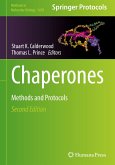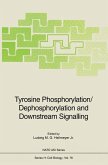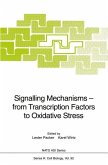Brian Henderson / A. Graham Pockley (eds.)
Molecular Chaperones and Cell Signalling
Herausgeber: Henderson, Brian; Pockley, A. Graham
Brian Henderson / A. Graham Pockley (eds.)
Molecular Chaperones and Cell Signalling
Herausgeber: Henderson, Brian; Pockley, A. Graham
- Gebundenes Buch
- Merkliste
- Auf die Merkliste
- Bewerten Bewerten
- Teilen
- Produkt teilen
- Produkterinnerung
- Produkterinnerung
This 2005 text reviews understanding of the biological roles of extracellular molecular chaperones.
Andere Kunden interessierten sich auch für
![Phosphoinositide 3-Kinase Signalling Pathway: The Key to Cell Proliferation and Death Phosphoinositide 3-Kinase Signalling Pathway: The Key to Cell Proliferation and Death]() Eric Wing-Fai LamPhosphoinositide 3-Kinase Signalling Pathway: The Key to Cell Proliferation and Death140,99 €
Eric Wing-Fai LamPhosphoinositide 3-Kinase Signalling Pathway: The Key to Cell Proliferation and Death140,99 €![Molecular Chaperones Molecular Chaperones]() Molecular Chaperones89,99 €
Molecular Chaperones89,99 €![Molecular Chaperones Molecular Chaperones]() Molecular Chaperones125,99 €
Molecular Chaperones125,99 €![Biological Membranes: Structure, Biogenesis and Dynamics Biological Membranes: Structure, Biogenesis and Dynamics]() Biological Membranes: Structure, Biogenesis and Dynamics81,99 €
Biological Membranes: Structure, Biogenesis and Dynamics81,99 €![Chaperones Chaperones]() Chaperones177,99 €
Chaperones177,99 €![Tyrosine Phosphorylation/Dephosphorylation and Downstream Signalling Tyrosine Phosphorylation/Dephosphorylation and Downstream Signalling]() Tyrosine Phosphorylation/Dephosphorylation and Downstream Signalling83,99 €
Tyrosine Phosphorylation/Dephosphorylation and Downstream Signalling83,99 €![Signalling Mechanisms ¿ from Transcription Factors to Oxidative Stress Signalling Mechanisms ¿ from Transcription Factors to Oxidative Stress]() Signalling Mechanisms ¿ from Transcription Factors to Oxidative Stress81,99 €
Signalling Mechanisms ¿ from Transcription Factors to Oxidative Stress81,99 €-
-
-
This 2005 text reviews understanding of the biological roles of extracellular molecular chaperones.
Hinweis: Dieser Artikel kann nur an eine deutsche Lieferadresse ausgeliefert werden.
Hinweis: Dieser Artikel kann nur an eine deutsche Lieferadresse ausgeliefert werden.
Produktdetails
- Produktdetails
- Verlag: Cambridge University Press
- Seitenzahl: 346
- Erscheinungstermin: 11. Januar 2016
- Englisch
- Abmessung: 235mm x 157mm x 25mm
- Gewicht: 713g
- ISBN-13: 9780521836548
- ISBN-10: 0521836549
- Artikelnr.: 34935077
- Herstellerkennzeichnung
- Libri GmbH
- Europaallee 1
- 36244 Bad Hersfeld
- gpsr@libri.de
- Verlag: Cambridge University Press
- Seitenzahl: 346
- Erscheinungstermin: 11. Januar 2016
- Englisch
- Abmessung: 235mm x 157mm x 25mm
- Gewicht: 713g
- ISBN-13: 9780521836548
- ISBN-10: 0521836549
- Artikelnr.: 34935077
- Herstellerkennzeichnung
- Libri GmbH
- Europaallee 1
- 36244 Bad Hersfeld
- gpsr@libri.de
Brian Henderson is Professor of Cell Biology at the Eastman Dental Institute, University College London and head of the Cellular Microbiology Research Group. He is the coauthor of Bacterial Disease Mechanisms (2002) and the coeditor of Bacterial Evasion of Host Immune Responses (2003). His major research interests are concerned with bacterial interactions with the host and how such interactions control inflammation and associated tissue destruction. It is through these studies that he identified that molecular chaperones are bacterial virulence factors and started his interest in the direct immunomodulatory actions of cell stress proteins.
A. Graham Pockley is Professor of Immunobiology at the University of Sheffield Medical School and is head of the Immunobiology Research Unit. Professor Pockley has long-standing interests in the immunobiology of transplant rejection and his Unit is currently focussed on research relating to the biology and immunotherapeutic potential of heat shock proteins, particularly their involvement in the rejection of organ transplants and the development and progression of cardiovascular disease.
A. Graham Pockley is Professor of Immunobiology at the University of Sheffield Medical School and is head of the Immunobiology Research Unit. Professor Pockley has long-standing interests in the immunobiology of transplant rejection and his Unit is currently focussed on research relating to the biology and immunotherapeutic potential of heat shock proteins, particularly their involvement in the rejection of organ transplants and the development and progression of cardiovascular disease.
Preface; Part I. Molecular Chaperones and the Cell Stress Response: 1.
Chaperone function: the orthodox view R. J. Ellis; 2. Intracellular
disposition of mitochondrial molecular chaperones: Hsp60, mHsp70, Cpn10 and
TRAP-1 R. S. Gupta, T. Bowes, S. Sadacharan and B. Singh; Part II. Changing
Paradigms of Protein Trafficking and Protein Function: 3. Novel pathways of
protein secretion G. Chimini and A. Rubartelli; 4. Moonlighting proteins:
proteins with more than one function C. J. Jeffery; 5. Molecular
chaperones: the unorthodox view B. Henderson and A. Shamaei-Tousi; Part
III. Molecular Chaperones as Cell Regulators: 6. Cell-cell signalling
properties of chaperonins A. R. M. Coates; 7. Toll-like receptor-dependent
activation of antigen presenting cells by Hsp60, Hsp70 and Gp96 R. M.
Vabulas and H. Wagner; 8. Regulation of signal transduction by
intracellular and extracellular Hsp70 A. Asea and S. Calderwood; 9. Hsp72
and cell signalling M. Y. Sherman; 10. Heat shock proteins, their cell
surface receptors and effect on the immune system T. Lehner, Y. Wang, T.
Whittall and L. A. Bergmei; 11. Molecular chaperone-Cytokine interactions
at the transcriptional level A. Stephanou and D. S. Latchman; Part IV.
Physiological and Pathophysiological Signals: 12. Heat shock protein
release and naturally-occurring exogenous heat shock proteins J. Frostegård
and A. G. Pockley; 13. Hsp27 as an anti-inflammatory Protein K. Laudanski,
A. De and C. Miller-Graziano; 14. Bip, a negative immune regulator involved
in rheumatoid arthritis V. M. Corrigal and G. S. Panayi; Part V. Molecular
Chaperones as Therapeutics: 15. Neuroendocrine aspects of the molecular
chaperones ADNF and ADNP I. Gozes, I. Vulih, I. Spivak-Pohis and S. Furman;
16. Heat shock proteins regulate by both molecular and network
cross-reactivity F. J. Quintana and I. R. Cohen; 17. Heat shock protein
fusions: a platform for the induction of antigen-specific immunity L.
Mizzen and J. Neefe; 18. Molecular chaperones as inducers of tumour
immunity P. P. Bannerjee and Z. Li; Part VI. What Does the Future Hold?:
19. Gazing into the crystal ball: the unfolding future of molecular
chaperones L. Hightower.
Chaperone function: the orthodox view R. J. Ellis; 2. Intracellular
disposition of mitochondrial molecular chaperones: Hsp60, mHsp70, Cpn10 and
TRAP-1 R. S. Gupta, T. Bowes, S. Sadacharan and B. Singh; Part II. Changing
Paradigms of Protein Trafficking and Protein Function: 3. Novel pathways of
protein secretion G. Chimini and A. Rubartelli; 4. Moonlighting proteins:
proteins with more than one function C. J. Jeffery; 5. Molecular
chaperones: the unorthodox view B. Henderson and A. Shamaei-Tousi; Part
III. Molecular Chaperones as Cell Regulators: 6. Cell-cell signalling
properties of chaperonins A. R. M. Coates; 7. Toll-like receptor-dependent
activation of antigen presenting cells by Hsp60, Hsp70 and Gp96 R. M.
Vabulas and H. Wagner; 8. Regulation of signal transduction by
intracellular and extracellular Hsp70 A. Asea and S. Calderwood; 9. Hsp72
and cell signalling M. Y. Sherman; 10. Heat shock proteins, their cell
surface receptors and effect on the immune system T. Lehner, Y. Wang, T.
Whittall and L. A. Bergmei; 11. Molecular chaperone-Cytokine interactions
at the transcriptional level A. Stephanou and D. S. Latchman; Part IV.
Physiological and Pathophysiological Signals: 12. Heat shock protein
release and naturally-occurring exogenous heat shock proteins J. Frostegård
and A. G. Pockley; 13. Hsp27 as an anti-inflammatory Protein K. Laudanski,
A. De and C. Miller-Graziano; 14. Bip, a negative immune regulator involved
in rheumatoid arthritis V. M. Corrigal and G. S. Panayi; Part V. Molecular
Chaperones as Therapeutics: 15. Neuroendocrine aspects of the molecular
chaperones ADNF and ADNP I. Gozes, I. Vulih, I. Spivak-Pohis and S. Furman;
16. Heat shock proteins regulate by both molecular and network
cross-reactivity F. J. Quintana and I. R. Cohen; 17. Heat shock protein
fusions: a platform for the induction of antigen-specific immunity L.
Mizzen and J. Neefe; 18. Molecular chaperones as inducers of tumour
immunity P. P. Bannerjee and Z. Li; Part VI. What Does the Future Hold?:
19. Gazing into the crystal ball: the unfolding future of molecular
chaperones L. Hightower.
Preface; Part I. Molecular Chaperones and the Cell Stress Response: 1.
Chaperone function: the orthodox view R. J. Ellis; 2. Intracellular
disposition of mitochondrial molecular chaperones: Hsp60, mHsp70, Cpn10 and
TRAP-1 R. S. Gupta, T. Bowes, S. Sadacharan and B. Singh; Part II. Changing
Paradigms of Protein Trafficking and Protein Function: 3. Novel pathways of
protein secretion G. Chimini and A. Rubartelli; 4. Moonlighting proteins:
proteins with more than one function C. J. Jeffery; 5. Molecular
chaperones: the unorthodox view B. Henderson and A. Shamaei-Tousi; Part
III. Molecular Chaperones as Cell Regulators: 6. Cell-cell signalling
properties of chaperonins A. R. M. Coates; 7. Toll-like receptor-dependent
activation of antigen presenting cells by Hsp60, Hsp70 and Gp96 R. M.
Vabulas and H. Wagner; 8. Regulation of signal transduction by
intracellular and extracellular Hsp70 A. Asea and S. Calderwood; 9. Hsp72
and cell signalling M. Y. Sherman; 10. Heat shock proteins, their cell
surface receptors and effect on the immune system T. Lehner, Y. Wang, T.
Whittall and L. A. Bergmei; 11. Molecular chaperone-Cytokine interactions
at the transcriptional level A. Stephanou and D. S. Latchman; Part IV.
Physiological and Pathophysiological Signals: 12. Heat shock protein
release and naturally-occurring exogenous heat shock proteins J. Frostegård
and A. G. Pockley; 13. Hsp27 as an anti-inflammatory Protein K. Laudanski,
A. De and C. Miller-Graziano; 14. Bip, a negative immune regulator involved
in rheumatoid arthritis V. M. Corrigal and G. S. Panayi; Part V. Molecular
Chaperones as Therapeutics: 15. Neuroendocrine aspects of the molecular
chaperones ADNF and ADNP I. Gozes, I. Vulih, I. Spivak-Pohis and S. Furman;
16. Heat shock proteins regulate by both molecular and network
cross-reactivity F. J. Quintana and I. R. Cohen; 17. Heat shock protein
fusions: a platform for the induction of antigen-specific immunity L.
Mizzen and J. Neefe; 18. Molecular chaperones as inducers of tumour
immunity P. P. Bannerjee and Z. Li; Part VI. What Does the Future Hold?:
19. Gazing into the crystal ball: the unfolding future of molecular
chaperones L. Hightower.
Chaperone function: the orthodox view R. J. Ellis; 2. Intracellular
disposition of mitochondrial molecular chaperones: Hsp60, mHsp70, Cpn10 and
TRAP-1 R. S. Gupta, T. Bowes, S. Sadacharan and B. Singh; Part II. Changing
Paradigms of Protein Trafficking and Protein Function: 3. Novel pathways of
protein secretion G. Chimini and A. Rubartelli; 4. Moonlighting proteins:
proteins with more than one function C. J. Jeffery; 5. Molecular
chaperones: the unorthodox view B. Henderson and A. Shamaei-Tousi; Part
III. Molecular Chaperones as Cell Regulators: 6. Cell-cell signalling
properties of chaperonins A. R. M. Coates; 7. Toll-like receptor-dependent
activation of antigen presenting cells by Hsp60, Hsp70 and Gp96 R. M.
Vabulas and H. Wagner; 8. Regulation of signal transduction by
intracellular and extracellular Hsp70 A. Asea and S. Calderwood; 9. Hsp72
and cell signalling M. Y. Sherman; 10. Heat shock proteins, their cell
surface receptors and effect on the immune system T. Lehner, Y. Wang, T.
Whittall and L. A. Bergmei; 11. Molecular chaperone-Cytokine interactions
at the transcriptional level A. Stephanou and D. S. Latchman; Part IV.
Physiological and Pathophysiological Signals: 12. Heat shock protein
release and naturally-occurring exogenous heat shock proteins J. Frostegård
and A. G. Pockley; 13. Hsp27 as an anti-inflammatory Protein K. Laudanski,
A. De and C. Miller-Graziano; 14. Bip, a negative immune regulator involved
in rheumatoid arthritis V. M. Corrigal and G. S. Panayi; Part V. Molecular
Chaperones as Therapeutics: 15. Neuroendocrine aspects of the molecular
chaperones ADNF and ADNP I. Gozes, I. Vulih, I. Spivak-Pohis and S. Furman;
16. Heat shock proteins regulate by both molecular and network
cross-reactivity F. J. Quintana and I. R. Cohen; 17. Heat shock protein
fusions: a platform for the induction of antigen-specific immunity L.
Mizzen and J. Neefe; 18. Molecular chaperones as inducers of tumour
immunity P. P. Bannerjee and Z. Li; Part VI. What Does the Future Hold?:
19. Gazing into the crystal ball: the unfolding future of molecular
chaperones L. Hightower.

